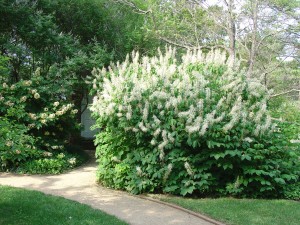If you have lots of planting space, aggressive bottlebrush buckeye (Aesculus parvifolia) is what you want. This deciduous, multi-stemmed shrub grows 8 to 12 feet tall and 8 to 15 feet wide.A Southeastern U.S. native, bottlebrush buckeye is a late spring flowering shrub and requires little extra attention other than pruning. Plant in full sun in zones 5 and 6 and in partial shade in zones 7 and 8. It becomes very drought tolerant after two years establishment.
Older unkempt shrubs can become aggressive spreaders and grow taller and wider. Roots develop a strong suckering propensity. Suckers are easily checked by closely mowing around the shrub. Otherwise, a three gallon (#3 size container) shrub may eventually swallow up 300-400 square feet of ground in 20 years.
The white bottlebrush flowers in late spring-summer are spectacular. Reddish floral anthers add extra appeal. The white bottlebrush flower clusters are 12-18 inches long and stand tall above the foliage. Bottlebrush flowers for 2-3 weeks and attract numerous butterflies and other pollinators. A. parvifolia var serotina ‘Rogers’ blooms 3-4 weeks later than species.
Bottlebrush buckeye has bold dark green palmately compound (5-7 leaflets) foliage. This shrub belongs to nature’s “bold and beautiful” class. The compound foliage turns bright yellow for a short time in autumn before dropping.
Few diseases or insects mar the foliage compared to other buckeyes and horsechestnuts. Bottlebrush appears resistant to deer and rabbits, perhaps because of its aggressive growth habit.
The pear-shaped nuts (buckeyes), encased in husks, ripen in early fall. Collect early before critters swipe them. Fresh nuts should be planted immediately before they shrivel. Sow 2 inches deep in moist compost rich soil and several will germinate late next spring.
Bottlebrush buckeye is commonly available from e-commerce nursery sources on-line and from wholesale nurseries.


 Posted in
Posted in 
